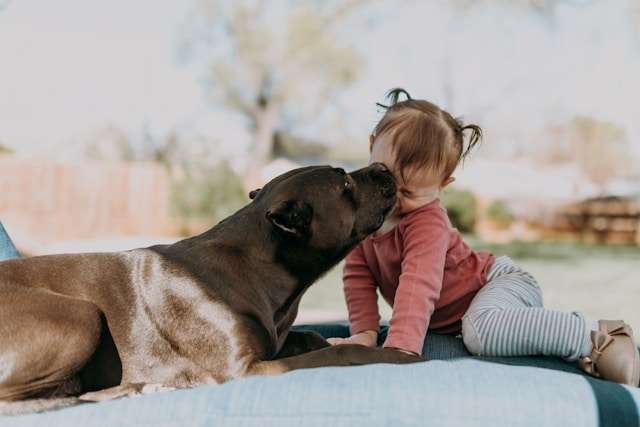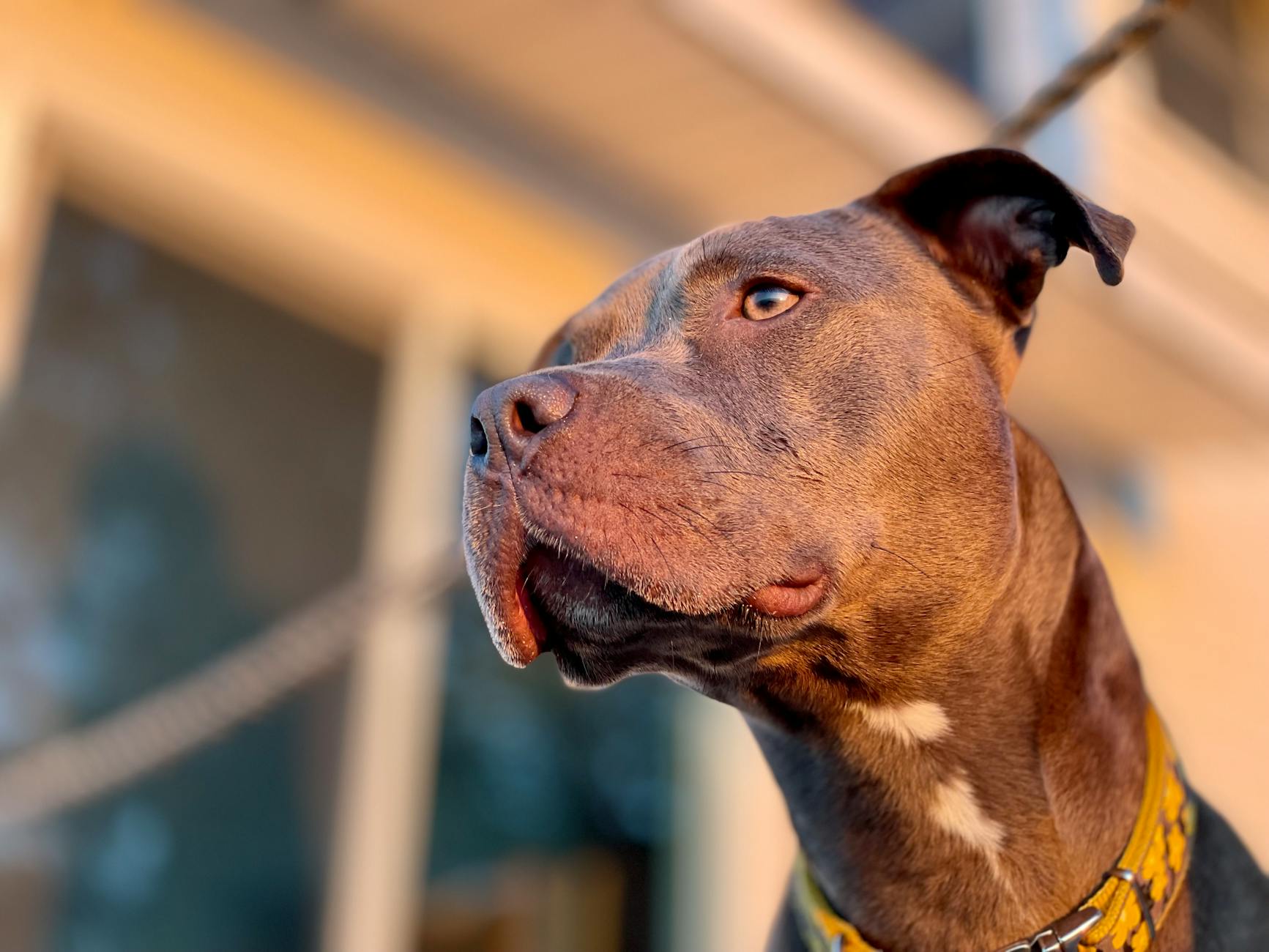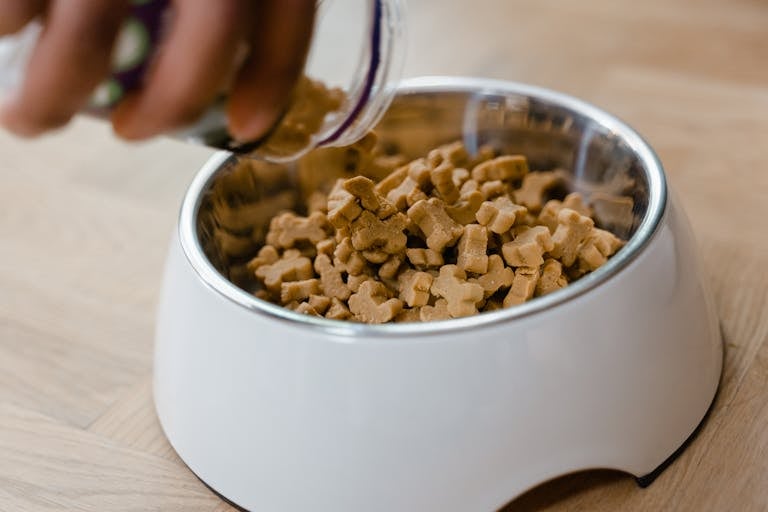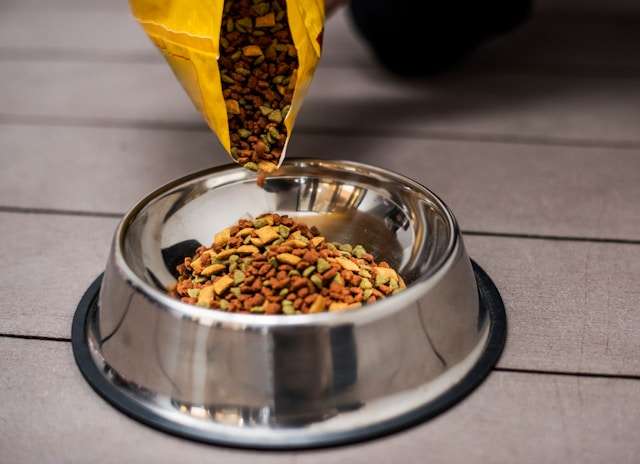Dog Foods for American Pit Bull Terriers

Dog Foods for American Pit Bull Terriers in 2024. American Pit Bull Terriers are full of energy, strength, and loyalty, making them a favorite among active dog owners. Known for their muscular build and stamina, these dogs need a diet that matches their high energy and physical demands.
High-protein foods support muscle growth, maintain activity levels, and promote overall health. Choosing the right dog food isn’t just about taste—it’s about ensuring your Pit Bull thrives throughout every stage of life.
Table of Contents
What Makes a High-Protein Dog Food Perfect for Pit Bull Terriers?
American Pit Bull Terriers are a powerhouse breed—energetic, muscular, and known for their stamina. Diet is key to fueling their muscular build and active lifestyle. Not just any food will do; high-protein formulas designed to their needs make all the difference.
The Role of Protein
Protein is the backbone of muscle repair, growth, and overall vitality for Pit Bull Terriers. These dogs have natural athleticism, and protein is their primary building block. It helps repair the muscle fibers that get stressed during play or exercise. Think of it as fuel for their high-performance engine.
Without sufficient protein, dogs may lose muscle mass, appear lethargic, or struggle with recovery after activity. This makes choosing the right food essential. Look for dog food with at least 30% protein content from quality sources like chicken, beef, fish, or lamb. Want a detailed breakdown? Check out options like Bully Max High Protein Dog Food.
Activity Level Requirements
Pit Bulls are not couch potatoes—they’re incredibly active and need enough calories to match their energy output. Whether it’s going for runs, playing tug-of-war, or just zooming around the yard, they burn more than the average dog.
Active breeds require a mix of high-protein and healthy fats to sustain their energy levels. A diet that includes fats like omega-3s will help with their energy and keep their coat shiny and skin healthy. Foods like We Feed Raw’s Protein-Rich Options cater specifically to active dogs and their unique requirements.
Key Features of Quality Dog Foods
Not all high-protein foods are created equal. The ideal dog food for Pit Bulls should tick several boxes to ensure it supports their health and lifestyle. Here’s what to look for:
- Whole-Meat Proteins: Aim for chicken, beef, fish, or lamb. Avoid vague labels like “meat meal” or “by-products.”
- Healthy Carbs for Energy: Think sweet potatoes, brown rice, or pumpkin.
- Balanced Fats: Look for omega-fatty acids from fish oil or flaxseed.
- No Fillers: Steer clear of corn, soy, or artificial additives.
- Digestive Support: Probiotics and prebiotics can be a lifesaver for dogs prone to sensitive stomachs.
Brands that prioritize quality often come with a higher price tag, but the health benefits outweigh the cost. Explore trusted options via Amazon’s Pit Bull Food Selections for a range suited to different needs and budgets.

Photo by Kelly
Selecting the perfect food ensures your Pit Bull Terrier enjoys optimal energy and a thriving life. Next, explore even more ways to support their unique dietary needs.
Top 5 High-Protein Dog Foods for Pit Bulls in 2024
American Pit Bull Terriers need a high-protein diet to maintain their muscular build and active lifestyle. Whether running around the backyard or joining you on a jog, their food should fuel their energy and keep them in top condition. Here’s a list of the best high-protein dog foods for Pit Bulls this year, packed with nutrients and designed to meet their unique needs.
1. Purina Pro Plan High-Protein Dog Food

Photo by Gilberto Reyes
Purina Pro Plan understands the demands of an athletic breed like the Pit Bull. Their high-protein formula, featuring real chicken or salmon as the first ingredient, is specifically crafted for active dogs. This blend promotes lean muscle development, which is critical for breeds with a muscular build.
Key benefits include:
- Rich in essential amino acids to support muscle recovery.
- Added probiotics help with digestion for dogs with sensitive stomachs.
- Available in both dry and wet options for variety.
Want more details? Check out the Dog Food Advisor’s list of high-protein options.
2. Orijen Six Fish Grain-Free Dry Dog Food
Orijen’s Six Fish formula is worth considering if your Pit Bull is always on the go. This dog food uses six types of wild-caught fish as its protein source, ensuring your dog gets quality protein alongside omega-3 fatty acids.
Why it’s perfect for active breeds like Pit Bulls:
- It is packed with 85% premium animal ingredients—ideal for high-energy needs.
- Grain-free, which can be easier to digest.
- It helps improve coat and skin health thanks to fish oils.
Orijen is a favorite for its biologically appropriate recipes. Learn more about it in this nutritional guide for active breeds.
3. Ollie Chicken Dish with Carrots
Ollie’s fresh food options are great for Pit Bulls who thrive on real, human-grade ingredients. Their Chicken Dish with Carrots stands out, featuring farm-raised chicken as the primary protein source. Combined with veggies like carrots and sweet potatoes, this recipe delivers balanced nutrition.
What makes it unique:
- Customized meal plans tailored to your dog’s specific needs.
- No artificial fillers or by-products—just clean, fresh ingredients.
- Thanks to its great taste, it’s easier for picky eaters to enjoy.
Ollie provides subscription-based fresh food, making it a convenient option for owners who want the best for their dogs.
4. Best Dog Food for American Bullies
American Pit Bull Terriers share a lot of traits with American Bullies, including muscle mass and activity levels. High-protein foods designed for Bullies, such as grain-free beef or chicken recipes, are also suitable for Pit Bulls. These foods often contain 30% protein or more, helping maintain their robust physique.
Key benefits of these high-protein meals:
- Enhance muscle tone and recovery after exercise.
- Sustain energy throughout the day’s activities.
- Balanced with healthy fats for joint and coat health.
For a closer look, check out Tractor Supply’s top-rated dog foods for Pit Bulls.
5. Nutritional Guide for Pit Bulls and Active Breeds
Understanding your Pit Bull’s nutritional needs ensures they stay healthy and active. Generally, these dogs need:
- Protein: 30-40% for muscle maintenance and growth.
- Fats: About 20% to support energy and coat health.
- Carbs: Limited, focusing on sweet potatoes or brown rice for easier digestion.
- Supplements: Omega-3s and probiotics for skin, joint, and gut health.
To tailor a diet plan for your dog, explore this guide to feeding American Pit Bulls. It’s packed with tips to keep them thriving.
Choosing the right food for your Pit Bull doesn’t just enhance their daily energy—it ensures their long-term health and happiness. Stay tuned for more top suggestions tailored to your dog’s unique needs!
Signs Your Pit Bull Needs a Protein-Rich Diet
A healthy, active Pit Bull thrives on a well-balanced diet with plenty of protein. Protein is vital in maintaining muscular build, high energy levels, and overall vitality. When protein intake falls short, it’s often reflected in their behavior, appearance, and health. You can adjust their diet to suit their needs by recognizing the signs early.
Common Symptoms
If your pit bull isn’t getting enough protein, its body will signal noticeably. Pay close attention to physical changes, including:
- Low energy levels: Does your dog seem unusually tired or reluctant to play? A lack of protein may result in fatigue since muscles can’t recover efficiently.
- Muscle loss: Pit Bulls are naturally muscular. If you notice their body looking less defined, it could indicate insufficient protein for muscle maintenance.
- Poor coat quality: Protein also affects skin and fur. A dull or flaky coat can be a sign something is off.
- Weight loss: If your dog is dropping weight unexpectedly, their diet may lack the nutrients needed to maintain their ideal weight.
Want more insights on dog nutritional needs? Check out How Much Protein Does My Dog Need?.
Behavioral Cues
It’s not just about how they look—your Pit Bull’s behavior can also reveal nutritional deficiencies. Look for these behavioral changes:
- Increased irritability: Hunger or lack of nourishment can make dogs more reactive.
- Disinterest in exercise: If your once-energetic dog isn’t excited about their daily walks, they may lack the energy boost protein provides.
- Chewing or eating unusual items: Dogs with unbalanced diets sometimes eat dirt, grass, or even non-food objects—this might be their way of addressing a mineral or protein deficiency.
Learn the signs of common deficiencies by reading Signs and Symptoms of Nutritional Deficiencies in Dogs.
Monitoring Weight and Energy Levels
Keeping an eye on your Pit Bull’s weight and stamina can help you avoid potential dietary issues. Here are some practical tips:
- Track their weight weekly: Weigh your dog regularly at home or during vet visits to maintain a steady weight.
- Monitor activity levels: Use apps or observe how long they can play or run without tiring. Sudden declines could signal dietary issues.
- Perform a body check: Run your hands along their sides. You should feel their ribs but not see them. Visible ribs might indicate weight loss, a sign of insufficient protein intake.
- Talk to your vet: If unsure about your diet, consult a professional for tailored advice.
For more details on what to feed your Pit Bull, explore The Ultimate Pit Bull Feeding Guide.

Photo by Jnt Airdrop
These signs can be subtle but are crucial to catching early. Your Pit Bull relies on you for proper nutrition—watch closely and make adjustments when necessary.
Tips for Transitioning to High-Protein Food
Transitioning your American Pit Bull Terrier to a high-protein diet must be done thoughtfully. As a breed known for its muscular build and energetic lifestyle, proper nutrition is key to its health and activity levels. Abrupt dietary changes can cause digestive upset, so taking it step by step is essential.
Gradual Switching Techniques
Switching your Pit Bull’s food slowly is essential to prevent stomach upset. Dogs thrive on routine; sudden changes can throw their digestive system off balance. Here’s how to make the switch:
- Start Small: Mix about 25% of the new high-protein food with 75% of their old food.
- Monitor Their Reaction: Watch out for signs of upset stomach, such as vomiting or diarrhea. If everything looks OK, you can gradually increase the ratio.
- Step it Up: Over the next 7–10 days, increase the proportion of the new food by 10–20% each day until they’re fully transitioned.
- Stay Patient: If your dog shows difficulty, slow down the process by sticking to the same ratio for a few extra days.
For more tips on making the change smooth, visit How to Switch Dog Foods.

Photo by Anastasia Shuraeva
Recommended Portion Sizes
Knowing how much to feed your Pit Bull is just as important as what you feed them. Overfeeding can lead to weight gain, while underfeeding may result in energy deficits and muscle loss. Here’s a general guideline:
- For an adult Pit Bull, protein-rich foods should comprise 2–4 cups per day, divided into two meals.
- You might need to increase portion sizes slightly for active or working dogs to meet higher calorie demands.
- Puppies require smaller portions more frequently throughout the day to support growth and development.
Always check the feeding chart on your dog food packaging or get personalized advice from your vet. For more on portion sizes, check out Dog Feeding Chart.
Importance of Hydration
High-protein diets can sometimes increase thirst. Protein metabolizes differently than fats or carbohydrates and may place more demands on your Pit Bull’s kidneys. Ensure your dog always has access to fresh, clean water to stay hydrated.
- Keep Water Accessible: Place water bowls in multiple areas of your home.
- Monitor Their Intake: If you notice they’re not drinking enough, add a little low-sodium broth to their water for encouragement.
- Moisture-Rich Foods: Adding wet dog food or hydrating toppers to their meals can boost their water intake.
Proper hydration also supports digestion, making transitioning to a higher protein intake easier. Learn more about the role of hydration in diet changes at How To Transition Your Dog To A High Protein Diet.
Making these adjustments will ensure your Pit Bull transitions smoothly and keep them energized and healthy in the long run.
FAQs About Nutrition for American Pit Bull Terriers
When it comes to feeding your American Pit Bull Terrier, there are often questions about the best practices and dietary choices. Below, we’ll address some of the most common concerns to help you make informed decisions for your furry friend.
What is the healthiest protein source for American Pit Bull Terriers?
High-quality, animal-based proteins are the top choice for Pit Bulls. These include chicken, beef, turkey, lamb, and fish. Animal proteins provide essential amino acids necessary for muscle growth and maintenance. Fish, like salmon, offers the added benefit of omega-3 fatty acids, which promote skin health and a shiny coat.
Raw or freshly cooked proteins can also benefit pet owners who prefer natural diets. However, not all human-grade proteins suit dogs, so always check with your veterinarian. Explore detailed options in this guide to the best food for Pit Bulls.
How much protein do Pit Bulls need daily?
Pit Bulls typically require 30–40% of their daily caloric intake from protein, depending on their age, weight, and activity level. Puppies and highly active dogs may skew toward the higher end, while older or less active Pit Bulls might need slightly less.
For example:
- A 50-pound adult Pit Bull with moderate activity needs about 1,000 calories daily, with at least 300 calories from protein sources.
- Constantly adjust portions based on your dog’s specific needs to avoid overfeeding.
For more tips on portion sizes, check out The Ultimate Pit Bull Feeding Guide.
Are grain-free diets better for Pit Bulls?
Not necessarily. Grain-free diets have gained popularity, but they’re not always the best choice for every dog. Grains like oatmeal, brown rice, and barley can be an essential energy source and fiber. While some Pit Bulls with specific allergies or sensitivities may benefit from grain-free foods, these diets have also been linked to potential heart issues in particular dogs.
Consult your vet before making the switch. Learn whether grain-free diets are proper for Pit Bulls by reading Should I Feed My Dog Grain-Free Diet?.
Can high-protein diets cause health problems in dogs?
A balanced, high-protein diet does not harm the average healthy Pit Bull. However, excessive protein can strain the kidneys, especially in dogs with pre-existing kidney or liver conditions. It could also lead to weight gain if portions aren’t adequately controlled.
Signs of too much protein include:
- Digestive issues like diarrhea.
- Excessive thirst or urination due to kidney stress.
- Behavioral changes such as restlessness.
If you’re considering a high-protein diet, consult your vet to ensure it matches your dog’s needs. Read about the potential dangers of high-protein dog foods here.
How do you identify high-quality dog food?
The right dog food for your Pit Bull should include:
- Whole animal proteins are the first ingredient (e.g., chicken, beef, or fish).
- Healthy fats from sources like fish oil or flaxseed.
- Limited fillers such as by-products, corn, or soy.
- Natural additives like probiotics, not artificial preservatives.
Look for a nutritional adequacy statement that confirms the food meets AAFCO standards. Quality brands often highlight their protein sources and avoid vague terms like “meat meal.” For more details, check out How to Choose the Best Dog Food.

Photo by Steve DiMatteo
Making informed choices about your Pit Bull’s diet ensures a healthier, happier dog.
Conclusion
Feeding your American Pit Bull Terrier isn’t just about picking any high-protein dog food; it’s about finding a balance that supports their lifestyle. A protein-rich diet fuels their muscles, keeps their energy levels high, and ensures they look and feel their best. Focus on quality ingredients, avoid empty fillers, and choose options tailored to active breeds.
Your Pit Bull deserves a diet as strong and dependable as they are. Explore the recommended options shared here, and see the difference it makes in their health and happiness. Which brand works best for your Pit Bull? Share your favorites in the comments!
FAQs About American Pitbull Terriers
American Pit Bull Terriers are unique dogs with specific dietary needs and lifestyle requirements. If you’re a proud Pit Bull owner or considering bringing one into your home, these frequently asked questions will help you better understand how to meet their nutritional and general needs.
What food should I feed my American Pit Bull Terrier?
Pit Bulls thrive on high-protein diets with whole, animal-based ingredients. Foods that list real chicken, beef, fish, or lamb as the first ingredients are often the best choices. Complex carbohydrates like sweet potatoes or brown rice add essential energy without causing spikes in blood sugar.
Avoid fillers such as corn, soy, or artificial preservatives. These provide minimal nutritional value and can lead to digestive issues. For more details, check out this Pit Bull Feeding Guide.
How often should a Pit Bull eat?
Adult Pit Bulls should eat two meals spaced evenly daily to provide consistent energy levels. Puppies need three to four smaller meals a day since their metabolism and growth rate are much higher.
Stick to a feeding schedule to regulate digestion and avoid problems like bloating. Want to learn more? Explore this Ultimate Pit Bull Feeding Guide.
Are there specific foods to avoid for Pit Bulls?
Some foods can harm your dog or fail to meet their dietary needs. Here’s what to avoid:
- Chocolate: Contains theobromine, which is toxic to dogs.
- Onions and Garlic: Both can trigger anemia in dogs.
- Cooked Bones: These can splinter and cause internal injuries.
- Fillers and Artificial Preservatives: Low-quality ingredients like corn, soy, and by-products should be avoided.
Learn more about harmful foods your Pit Bull should never eat here.
What are the signs that my Pit Bull’s diet is lacking?
If your dog isn’t getting the nutrients they need, there will often be clear signs, such as:
- Low energy levels
- Reduced muscle tone
- Dry or flaky coat
- Unexpected weight loss
Behavioral changes like irritability or disinterest in activities can also signal dietary deficiencies. For a comprehensive breakdown of symptoms, visit American Pit Bull Nutrition Tips.
Is a grain-free diet better for American Pit Bull Terriers?
Grain-free diets have mixed opinions among pet owners and experts. While grains like brown rice or oatmeal offer valuable energy and fiber, some dogs have allergies or sensitivities that make grain-free options a better fit. However, researchers have linked some grain-free diets to heart health concerns, so it’s crucial to consult your vet.
Curious about whether grain-free is right for your dog? This article on grain-free dog food offers valuable insights.

Photo by Nikola Čedíková
What supplements can improve my Pit Bull’s diet?
Supplements can provide extra support for specific concerns. Commonly recommended ones include:
- Omega-3 Fatty Acids: Promotes shiny coats and healthy skin.
- Glucosamine and Chondroitin: Great for joint and hip health.
- Probiotics: Helps with digestion and reduces bloating.
Always check with your vet before adding supplements to your dog’s routine. Find more on supplements and diet improvements in this guide.
These answers can guide you in caring for your American Pit Bull Terrier, ensuring a lifetime of health and energy. Remember that every dog is different—what works for one may not work for another! Adjust your approach for your furry companion as needed.
Bonus Resources
Dive deeper into finding the perfect dog or exploring various breeds for companionship and care. These resources are invaluable for anyone looking to understand the world of dogs better.
Dog Breed Guide: Link to a guide for finding the perfect dog breed

Photo by Blue Bird
Find Your Best Dog Match: A quick quiz that narrows down the best breeds for you.
- IAMS Breed Selector: Refine your options by size, talents, intelligence, and more.
- Orvis Breed Match Tool: Analyze hundreds of breeds to find your ideal furry friend.
- Dog Breed Guide: Find Your Perfect Companion
These tools make choosing the perfect dog educational and straightforward.
Dog Breeds and Photos Overview: Link to an overview of dog breeds for related information
Once you’ve identified the ideal breed, delve into specifics to prepare for your future companion. Some websites provide a rich catalog of breeds with details about traits, grooming needs, and training tips. If you’re curious, check out:
- AKC Dog Breeds List: Comprehensive details about each breed’s personality and care.
- DogTime’s Breed Database: A user-friendly resource for comparing breeds side by side.
- SprucePets Guide to Dog Breeds: Learn about over 300+ recognized breeds worldwide.
These guides inform you about your new companion’s unique needs and quirks.







Your article helped me a lot, is there any more related content? Thanks!